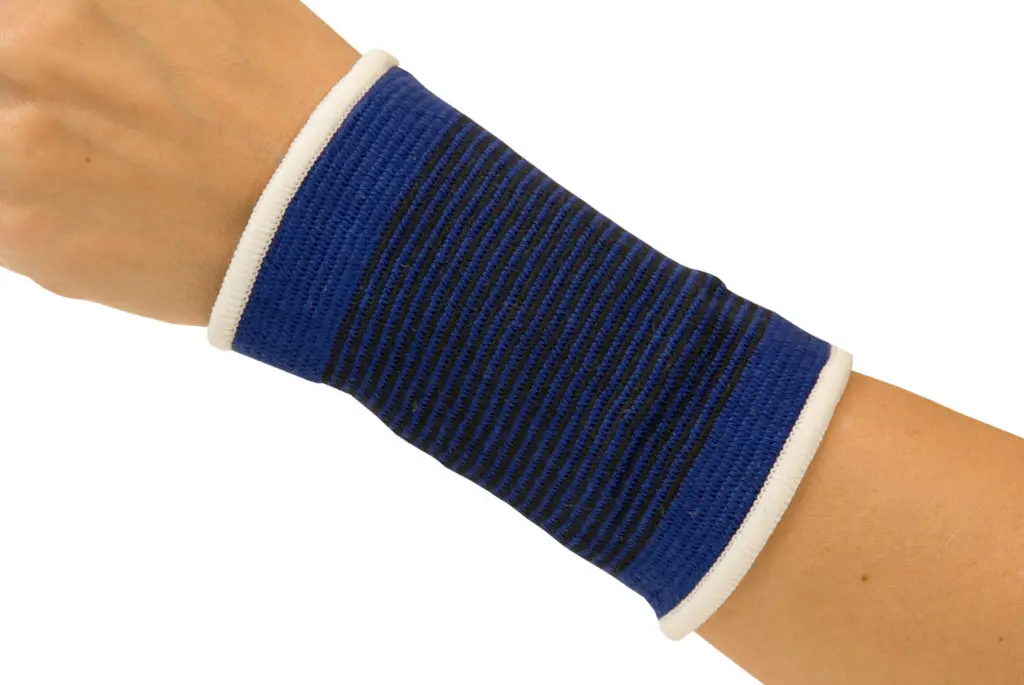
Wrist pain can happen for a number of reasons. The most common reason for wrist and hand pain is carpal tunnel syndrome, which occurs when you overuse the muscles and tendons in your wrists and hands.
Arthritis is another common culprit. This can easily inflame and irritate your wrists, making them hard to move back and forth without pain.
When you have wrist pain, every movement can hurt, and it can make every aspect of your life difficult; even the simplest things. Here are a few ways to minimize wrist pain for seniors and try to prevent wrist pain from occurring again.

10 Ways to Reduce Wrist Pain
1.Wear a brace or splint

Wearing a brace or splint can provide the support your wrist needs to keep it from hurting. Keeping your wrist stable and supported alleviates pain, especially when you need to continue to use your hands to complete tasks.
You can ask your doctor for advice about what type of splint or brace to purchase or buy one over the counter at any pharmacy. There are different types based on what type of pain you’re feeling and where your primary source of pain is.
You can wear the brace for as long as you need to, day and night. Remove it to stretch your hands and wrists when necessary. Otherwise, it won’t hurt to wear it frequently, especially when you’re using your hands or when you’re in pain.
You may find that after using the brace for awhile, your pain lessens and you can stop wearing it altogether, or only reach for it when you absolutely need it. Braces are easy to wear and usually secure with Velcro.
2. Pain medication

If you’re in a lot of pain and can’t go about your daily routine, you may need some medication. Using over-the-counter medication for pain can provide relief and lessen inflammation.
Some medications to try include ibuprofen, acetaminophen, and naproxen. Your doctor may give you a prescription for an anti-inflammatory that’s a little stronger, like Mobic, if you think you have a sprain in your wrist or something more serious.
Once you take medication, make sure and elevate and rest your wrist and hands. Try not to use them as frequently as you normally would to help lessen some of the pain.
Overuse can be damaging in the long-term, so you may have to change up your routine a little bit. If you do have to use your wrist, try and wear a brace or splint to keep it supported while you’re using it to keep pain to a minimum.
Always follow directions on the medication bottle, and call your doctor to make sure it’s okay for you to take medication if you’re taking other medications so you can be sure they don’t conflict with each other.
3. Ice it

Using ice is a good way to reduce swelling if your wrist and hand are feeling swollen and painful. To properly use ice to alleviate pain, apply ice in 20-minute increments several times a day.
If you don’t have an ice pack, you can use a bag of frozen vegetables. Just wrap the bag with a cloth and apply it to your wrist.
This should take down some swelling and help reduce pain, especially when you use this method in conjunction with taking pain relievers and resting.
If the swelling won’t go down, it’s possible you may have a break or sprain and you may need to contact your doctor. Otherwise, for average pain, you can usually manage it with home treatment.
Most wrist pain stems from overuse of muscles, and just like any other muscle in your body, they require rest, and ice is a good way to treat muscle pain at home.
4. Cortisone injections

For serious wrist pain, such as pain caused by arthritis, tendonitis, gout, bursitis, or carpal tunnel that won’t go away with home treatment, a cortisone injection is an option.
A cortisone shot is an immediate way to relieve yourself of the pain caused by wrist inflammation. It also decreases inflammation and swelling.
Though cortisone shots are most typically used in patients with arthritis, they can be used sparingly for other situations. However, they’re not a go-to method, as they can have effects over time, so they shouldn’t be overused.
But, if you have tried multiple other methods and still can’t find relief, you may want to ask your doctor about trying a cortisone shot.
The benefits of a cortisone shot can last for several months, which is definitely a plus, especially if your pain has become unmanageable and debilitating.
5. Wrist stretches

In certain situations, stretching your muscles and tendons can help them from tightening up, providing some relief of wrist and hand pain. The same is true for other types of pain, such as foot pain or knee pain.
If you can get to a physical therapist or even your doctor, he or she can provide you with some safe exercises you can do for your wrists.
Even yoga can help with wrist pain, and it’s low-impact, too. You can practice simple stretches at home, such as bending your wrists back gently for 30 seconds, clenching and unclenching your fists, and squeezing and unsqueezing a tennis ball for 10 seconds at a time.
Doing these exercises faithfully can strengthen your wrists, meaning that it’s less likely you will have pain or injure yourself during regular use of your wrists.
Always consult with your doctor before you do any exercises just to make sure they don’t aggravate any existing health issues and get advice on the best exercises for your particular wrist and hand issues.
6. Switch your keyboard and mouse

If you spend a lot of time on your computer, you may notice that your wrists hurt more after you’re done. This is because of the way you bend your wrists when you use your keyboard.
Using an ergonomic mouse and keyboard adds the support your wrists need when you type. They’re specially made to support your wrists so you don’t have pain as you use your computer.
These are popular with many people who enjoy using the computer for long periods of time, or already have wrist pain from another condition.
Some ergonomic keyboards have added padding you can sit your wrists on that feels good, and gives your wrists a place to sit as you type so you’re not just using your computer unsupported.
Using an ergonomic keyboard in conjunction with an ergonomic mouse gives you a greater chance to lessen pain from typing, gaming, or working on your computer. There are many brands that make these, and they aren’t too costly.
7. Use compression

Compression is a way to support the wrist that’s similar to a brace but it provides a tighter fit. It can give a bit more support especially if you have actually suffered from an injury, such as a sprain or a fracture.
To use compression, purchase a special compression wrap that fits snugly around your wrist. It doesn’t typically fit around your hand like a regular brace would, and it’s not padded like a brace.
Alternately, you can use a soft, stretchable bandage as a compression wrap. Simply wrap your wrist or have your pharmacist or doctor show you how to wrap it the proper way, and use medical tape or a clip to keep the bandage secure.
Once you have used a compression wrap or brace, elevate your wrist above your heart. This will help reduce swelling and gives you a chance to rest your injured or swollen wrist while the swelling goes down.
You can also take medication along with this technique to help alleviate the pain of your wrist injury.
8. Rest

It should go without saying, but many of us don’t stop to take the time we need to rest. If you’re suffering from arthritis, carpal tunnel, a sprain, or just overuse of your wrists, take the first 48 hours that you’re in the most pain and allow yourself to rest.
Prop your wrist or wrist up on a comfortable pillow or cushion above heart level, and take it easy.
Avoid doing things that would cause your wrist further pain, such as typing, gardening, or lifting anything heavy. Give yourself a break for a couple of days.
If you don’t rest a swollen, hurt wrist, you could end up making it worst, which could in turn lead to a larger problem that may require a trip to the doctor.
Life is busy and hectic, but your body will let you know when you need to take a break, so listen to it. While you’re resting, use ice, compression, or a brace, and take anti-inflammatory medication when needed.
It’s okay to ask for help from a friend, relative, or spouse, too!
9. Work on prevention

Make sure you avoid more wrist pain in the future. If you know you’ll be using your wrists and hands, stretch out a bit first to loosen the muscles.
If you’re doing anything athletic, you can tape or compress your wrists. If you’re typing or doing something else that requires overuse of your wrists, put your brace on for added support.
Use an ergonomic keyboard and mouse any time you need to type. When you’re doing tasks, try to switch hands so you’re not overusing one hand or wrist more frequently.
If you’re outside and it’s cold, wear gloves. Did you know that the cold can make your muscles stiffer and more prone to pain and injury?
Take frequent breaks when you do repetitive activities. Stretch out after 20 minutes or so, clenching your fists and releasing them and bending your fingers back and forth gently.
When you’re feeling pain, sleep with your brace on. Sometimes you may end up sleeping on your wrist or hurting yourself in the night.
If you sleep in your brace, you’ll have the support you need. Make sure it’s not on too tight and it’s comfortable to wear.
10. Know when to call a doctor

You may have injured yourself or feel wrist pain, but it doesn’t feel bad enough to go to the doctor.
So, you try some self-treatment at home, but it doesn’t seem to help very much. Keep in mind some of these signs that you may need to take your wrist or hand to your physician.
If you do self-care and your pain doesn’t improve or gets worse, it’s time to see a doctor. If you feel new symptoms coming on, such as pins and needles, numbness, increased swelling or bruising, get it looked at.
If your pain is over a 5 on the pain scale and it doesn’t improve in a few days, there may be something more serious going on.
Pain that travels up your arm to your forearm, neck, or shoulder may be caused by a pinched nerve or tendonitis, and your doctor can advise you on what to do in this situation.
There’s no reason to endure unnecessary pain – don’t ignore it!
Leave a Reply